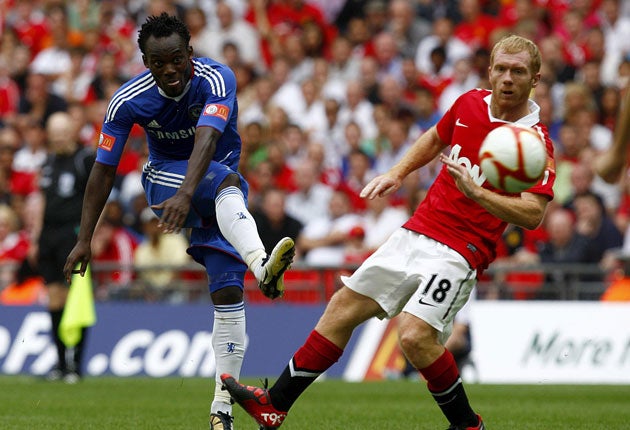Ancelotti welcomes back Essien, but what is his best position?

Your support helps us to tell the story
From reproductive rights to climate change to Big Tech, The Independent is on the ground when the story is developing. Whether it's investigating the financials of Elon Musk's pro-Trump PAC or producing our latest documentary, 'The A Word', which shines a light on the American women fighting for reproductive rights, we know how important it is to parse out the facts from the messaging.
At such a critical moment in US history, we need reporters on the ground. Your donation allows us to keep sending journalists to speak to both sides of the story.
The Independent is trusted by Americans across the entire political spectrum. And unlike many other quality news outlets, we choose not to lock Americans out of our reporting and analysis with paywalls. We believe quality journalism should be available to everyone, paid for by those who can afford it.
Your support makes all the difference.The £18.3m deal to sign the Brazilian midfielder Ramires has still to be completed but the return of Michael Essien to full fitness could prove a more telling development for Chelsea, come the end of the season.
Yesterday marked the return of Essien to the side, barring pre-season friendlies, for the first time since 8 December. While Manchester United still wait for their own dynamic midfielder, Owen Hargreaves, to fully regain fitness, Chelsea are relieved the powerful Ghanaian is again available.
This is a crucial season for Essien, who has torn ligaments in both his knees in the past two seasons. He managed 22 games last season, just 19 the one before.
His return to full fitness is undoubtedly one of the reasons manager Carlo Ancelotti has agreed with the board's decision not to offer new contracts to both Joe Cole and Michael Ballack, two important figures in last season's Double-winning campaign but who will both be starting new adventures with different clubs.
Chelsea are so confident that Essien has recovered completely from the ligament tear that ended his season last January – suffered while he was training with Ghana at the Africa Cup of Nations in Angola – that he has recently been offered improved terms on a longer contract, which ties him to the club for the next five years.
That seems quite a gamble by Chelsea, on a player with such a forlorn injury record. Essien tore his anterior cruciate ligament in his right knee in September 2008 and missed six months, returning in March the following year. Ten months later, he tore the medial ligament in his left knee, and suffered complications following surgery which ruled him out of the World Cup finals in South Africa.
Not so long ago, either of those injuries would have been more than enough to bring Essien's wonderful career to an end. Yet, yesterday, he was scurrying around Wembley, once again taking his place in the No 5 shirt for Chelsea, with the security of another five years with the champions.
This should be a seminal season for Essien, who needs to impose himself. The main priority will be for him to stay fit throughout the campaign, which, given his combative style, may be difficult. He could also take the opportunity to reinvent himself, and shrug off his reputation as a primarily defensive player. With Ramires set to join the club this week, and with John Obi Mikel still improving, the opportunity is there for Essien to become a more creative force for Chelsea, particularly in the absence of Cole and Ballack.
Essien was yesterday handed a more advanced role on the right side of Chelsea's midfield trio, with Mikel doing the defensive work and Frank Lampard resuming his role on the left. This was the position envisioned for him when he joined Chelsea in 2005, after the club had failed once again to tempt Steven Gerrard away from Liverpool.
Essien was one of Chelsea's better players against United, driving his team-mates forward when, at times, it seemed Ancelotti's champions were content to sit back and enjoy keeping possession on the halfway line.
However, it was arguable that, had he played in the holding role in front of the defence, Chelsea would have been a tighter unit and may not have lost the game. The goals were not directly the fault of Mikel but Essien is undoubtedly a better defensive midfielder than the Nigerian and might have been in the right place to prevent one or all of United's goals.
And therein lies the dilemma with Essien. If Ancelotti wants to harness his undoubted attacking prowess, he will sacrifice the player's unparalleled defensive work. Essien can't do both, although he sometimes tries.
The 27-year-old clearly has some way to go before he is fully fit. He was not quite the imposing presence of old, preferring to hassle and harry rather than launch into the kinds of crunching tackles that marked his first couple of seasons in the Premier League, following his £24m move from Lyons in 2005.
However, Essien also took the chance to show that he is far more than simply a midfield enforcer. His pass late on in the game to substitute Daniel Sturridge was a glorious demonstration of precision over distance, and deserved a better finish than the young Englishman provided, with his shot too close to United goalkeeper Edwin van der Sar.
It remains to be seen just how Ancelotti will choose to utilise Essien this season – whether he finds the courage to let the Ghanaian off the leash and give him the licence to attack, or sticks to the tried and tested formula of telling him to stop the opposition playing, denying them space. After missing Essien for the past eight months, Ancelotti is simply relieved to again have that choice to make.
Join our commenting forum
Join thought-provoking conversations, follow other Independent readers and see their replies
Comments